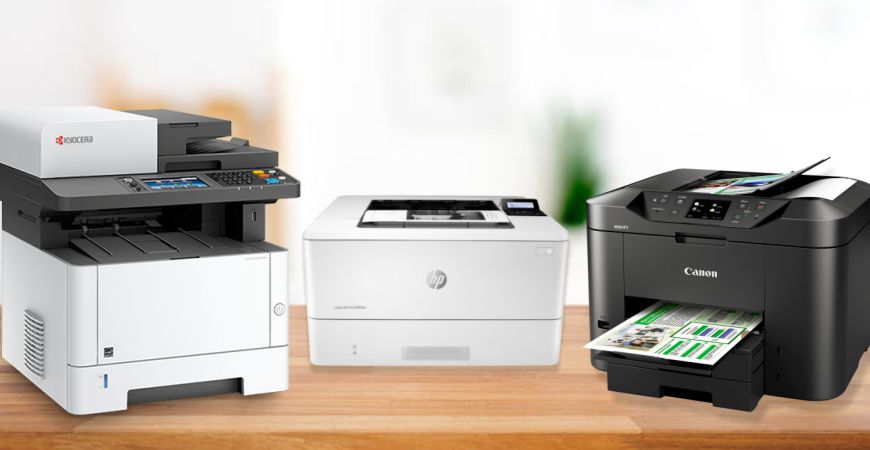In today’s business environment, having the right equipment is essential for maintaining productivity and efficiency. A printer is a key component of any office setup, whether you’re printing contracts, reports, marketing materials, or other important documents. While digital solutions have taken over many aspects of office life, the demand for physical copies of documents remains significant, particularly in sectors that require printed materials for legal or regulatory purposes. Selecting the right office printer can greatly impact both the performance and cost-effectiveness of your business operations.
In this article, we’ll examine different types of office printers, key features to look for, and how choosing the right one can benefit your business.
1. Types of Office Printers
There are several types of office printers to choose from, and the best option for your business will depend on your specific needs, such as print volume, quality requirements, and budget.
Inkjet Printers
Inkjet printers are known for producing high-quality colour prints, making them ideal for businesses that require vibrant and detailed images. They are particularly useful for printing marketing materials, presentations, and photographs. Inkjet printers work by spraying tiny droplets of ink onto the paper, creating a detailed and rich image.
However, while inkjet printers may have a lower upfront cost than laser printers, the cost of replacement ink cartridges can add up over time. This makes them less ideal for high-volume printing in the long run. These printers are best suited for small to medium-sized businesses that need high-quality prints but don’t have a high print volume.
Laser Printers
Laser printers are known for their speed and efficiency, making them ideal for offices with high-volume printing needs. They use toner (a powder) instead of ink and are much faster than inkjet printers. Laser printers also tend to have lower long-term operating costs, as toner cartridges last longer than ink cartridges, reducing the cost per page.
Monochrome laser printers are particularly useful for businesses that primarily print text-based documents, while colour laser printers are suitable for companies that need to print graphics or presentations. Laser printers are ideal for medium to large-sized businesses that require high print volumes and want to reduce printing costs over time.
Multifunction Printers (MFPs)
Multifunction printers (MFPs) combine printing, scanning, copying, and sometimes faxing into one device. These all-in-one machines are a great solution for offices that want to reduce the number of separate devices needed for these functions. They are available in both inkjet and laser models, giving businesses flexibility in choosing the right option based on their volume and quality needs.
For offices that require frequent scanning or copying, an MFP can help streamline operations, save space, and improve workflow. MFPs are perfect for businesses looking for an all-in-one solution that can handle multiple office tasks.
2. Key Features to Consider
When choosing an office printer, there are several important features to consider beyond just whether it’s inkjet, laser, or multifunction.
Print Speed
Print speed, often measured in pages per minute (PPM), is critical for businesses with high-volume printing needs. Laser printers generally have much higher PPM than inkjet models, making them better suited for busy offices where fast turnaround is necessary. If your office frequently prints large documents, a higher PPM printer can prevent bottlenecks and improve productivity.
Print Quality
Print quality is another essential factor, especially for businesses that produce marketing materials or documents where presentation is important. Inkjet printers are known for producing high-quality, vibrant prints, making them ideal for detailed images or photographs. Laser printers, while faster, may not produce the same level of image detail but excel in producing sharp, clean text. Your choice will depend on whether you prioritise high-quality images or fast text-based printing.
Connectivity Options
Modern printers offer a variety of connectivity options, including wireless, wired, and cloud-based printing. Wireless printers are particularly convenient in offices where employees need to print from multiple devices, such as laptops, smartphones, and tablets. Wireless and cloud-based printing solutions can also be useful for remote workers or offices with flexible workspaces. Some printers support mobile printing through services like Google Cloud Print or Apple AirPrint, making it easy for employees to print from their mobile devices.
Paper Handling
For offices that print a variety of document types, such as envelopes, labels, or different sizes of paper, choosing a printer with flexible paper-handling capabilities is important. Look for a printer that can handle various paper sizes and types. Additionally, high-capacity paper trays can reduce the need for frequent refilling, which is particularly useful in high-demand environments. Duplex printing, which allows automatic double-sided printing, is another feature that can save time and paper, reducing costs and environmental impact.
Security Features
As cybersecurity concerns grow, so does the need for secure office equipment. Printers are no exception, especially in industries that handle sensitive data, such as healthcare, law, and finance. Many modern office printers come with built-in security features such as user authentication, encrypted data transmission, and secure print release, which ensures that sensitive documents are only printed when authorised personnel are present. These features are essential for protecting your business from data breaches and ensuring compliance with privacy regulations.
3. Total Cost of Ownership
When choosing a printer, it’s important to consider the total cost of ownership (TCO), which includes not just the upfront cost of the printer but also ongoing costs such as ink or toner, maintenance, and energy consumption. While inkjet printers are typically cheaper to purchase, they tend to have higher operating costs due to the frequent need to replace ink cartridges. On the other hand, laser printers, while more expensive upfront, have a lower cost per page and are often more cost-effective in the long term.
Energy-efficient models can also help reduce ongoing costs. Many modern printers come with energy-saving features such as sleep mode, which automatically powers down the printer when it’s not in use, reducing electricity consumption and cutting down on utility bills.
Conclusion
Choosing the right office printer is crucial for ensuring productivity, efficiency, and cost-effectiveness in your workplace. Whether your business requires the high-quality images of an inkjet printer, the speed and efficiency of a laser printer, or the versatility of a multifunction printer, it’s essential to assess your specific needs before making a decision.
By considering key factors such as print speed, quality, connectivity, and total cost of ownership, you can select a printer that meets your office’s demands while supporting long-term growth. A well-chosen office printer can significantly improve your document management processes, streamline operations, and ultimately contribute to a more efficient and productive work environment.










